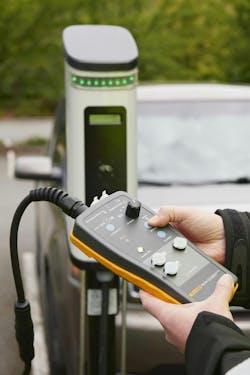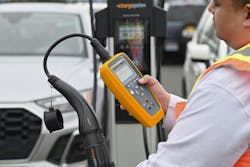Electric vehicle adoption continues to rise. Today, millions of electric vehicles (EVs) are on the road. This has created a growing demand for safe, reliable EV charging stations.
Like any new technology, the rapid expansion of EV infrastructure comes with a steep learning curve. It also raises several important questions: What’s the most effective way to avoid downtime? How can teams ensure compliance with industry standards and regulations? What kinds of safety precautions should workers follow?
This article will explore the essential routine maintenance required to keep the EV infrastructure in optimal condition. You’ll also learn about safety precautions and strategies to maximize efficiency.
Compliance: Keeping EV chargers up to standard
Electric vehicle charging systems are subject to international standards (IEC 61851-1 and ISO 15118) that set rules for interoperability and safety. The goal behind these standards is simple: consumers should be able to rely on charging stations to be safe, predictable, and uniform in functionality.
Just as drivers can count on gas stations to safely fuel their vehicles, EV drivers must depend on charging stations to keep their vehicles moving.
The basics
Routine maintenance for EV charging stations
Keeping charging stations functional starts with keeping them clean. This involves regularly changing filters, cleaning connection points, and checking ports to ensure they are clean, dry, and free of damage or contamination that could potentially lead to insulation faults.
During routine maintenance, workers should also check connection points to ensure fasteners and busbars are properly torqued and inspect wires/cables for signs of corrosion or excess wear and tear.
Safety and operability checks
Routine maintenance checks should also cover two main areas: safety and functionality. Is the charger successfully transferring energy to vehicles? Is it doing so safely and accurately?
For safety, it’s crucial to ensure that the charger never transfers energy until both ends of the charging process are securely connected. Similarly, the energy transfer from the charging station should immediately terminate in the event of a ground fault error.
There are several ways a charging station can fail or become unsafe. That’s why routine inspections are a key element of EV charging maintenance. Like any other preventive maintenance task, routine inspections of charging stations help to avoid any downtime. In the short term, this means lower maintenance costs, and, in the long term, it increases customer satisfaction and consumer confidence.
Selecting the right tools for the job
Choosing the right tools for maintaining EV charging stations is critical to ensuring safety, efficiency, and reliability. Given the complexity of these systems, maintenance teams need equipment that not only identifies faults but also supports comprehensive safety and performance testing. Here’s what to consider when selecting tools for the job:
- Functionality and versatility: Look for tools that offer a wide range of diagnostic capabilities. The tool should be able to test several aspects of the charging station, including voltage levels, ground fault detection, and communication between the charger and the vehicle. Versatility ensures that a single tool can handle multiple tasks, reducing the need for additional equipment.
- Ease of use: Given current labor shortages and the influx of less experienced technicians, it’s important to select user-friendly tools. Test equipment that requires minimal training yet delivers accurate and reliable results can help maintenance teams stay productive while reducing the risk of human error.
- Safety features: Safety should always be a top priority when working with high-voltage equipment. Tools equipped with built-in safety features (such as protective earth testing and automatic shutdown in the event of a fault) can help prevent accidents and protect workers from potential hazards.
- Durability and reliability: Maintenance tools are an investment, so durability is key. Reliable tools reduce the likelihood of productivity loss, ensuring that maintenance work can proceed without interruption. Choose tools that are built to withstand the tough conditions of fieldwork, including exposure to weather, dust, and rough handling.
- Support and training: Finally, consider the availability of technical support and training resources. Tools backed by comprehensive customer service, tutorials, and support networks can make a significant difference in how quickly your team can get up to speed and resolve any confusion that may arise.
By carefully selecting tools based on these considerations, maintenance teams can ensure they are equipped to keep EV charging stations operating safely and efficiently. The right tools not only enhance the quality of maintenance but also contribute to overall operational uptime and customer satisfaction.
Boosting uptime and efficiency
Routine maintenance can be a game changer for EV charging infrastructure. This is a rapidly growing sector, meaning the infrastructure may still be relatively untested. At the same time, MRO teams are facing labor shortages and a lack of experienced technicians. All of this means that nobody can afford unexpected downtime and certainly not major electrical failures. The best way to prevent these issues is to establish a solid preventive maintenance plan.
It’s worth noting that uptime isn’t just a nice-to-have. Some grant-giving agencies are providing specific requirements to encourage EV infrastructure maintenance. These funds often come with stewardship and upkeep requirements. For example, to qualify for a National Electric Vehicle Infrastructure (NEVI) grant, your charging stations must operate with at least 97% uptime.
The takeaway
A simple preventive maintenance program can keep EV charging stations functional, safe, and available. It’s an excellent way to reduce costs, maintain and document compliance, and ease the demand on technicians. It can also ensure incentives like grants and increase consumer confidence. In other words, it’s a win all around.
About the Author

Theo Brillhart
Theo Brillhart serves as the Technology Director at Fluke Corporation’s Research and Development division, where, for over 16 years, he has played a pivotal role in advancing innovative technologies. With extensive expertise in high-tech product development and growth acceleration, Theo leads a team of Senior and Principal Engineers focused on technology exploration, new product creation, and the establishment of global industry standards.
He has been deeply involved in developing international standards, collaborating with prominent organizations such as IEEE, SCTE, the Ethernet Alliance, SAE, and CharIN, while also making significant contributions to global standards through his involvement in multiple ISO and IEC technical committees.


